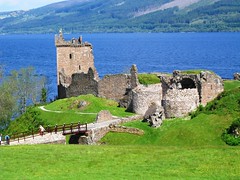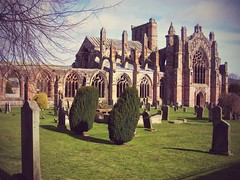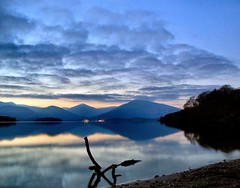Hillwalking in Scotland
Contents |
Hillwalking
Hillwalking & Climbing in Scotland | Cycling | Skiing | Surfing | Fishing | Golf | Wildlife Watching in Scotland | Outdoor Activities | Best Wildlife Watching Locations
Scotland is a walker's paradise. Throughout the country there are numerous marked trails, ranging from short walks to long-distance treks from one side of the country to the other. Whatever your taste or level of fitness and experience, you'll find plenty of opportunities to get off the beaten track and explore the countryside.
The best time for hiking in the mountains is usually from May to September, though in the more low-lying parts, April to October should be safe. Winter walking in the Highlands requires technical equipment such as ice axes and crampons and a lot of experience. July and August are the busiest times, though only the most popular routes, such as Ben Nevis, get really crowded.
Another problem during these months are midges. May to mid-June is probably the most pleasant time overall, as the weather can often be fine and the midges have yet to appear. September is also a good time, though it can be a lot colder.
Access
Scotland has a long tradition of generally free responsible access to mountain and moorland. This free access, of course, relies on walkers behaving responsibly and recognizing that the countryside is a place of work as well as recreation. Most land in Scotland is privately owned and at certain times of the year, such as the main shooting seasons, walkers may be asked to respect certain restrictions on access.
The main deer stalking season runs from mid-August to 20 October and the grouse shooting season is between 12 August (referred to as the 'Glorious Twelfth') and 10 December. For more information on this, see Heading for the Scottish Hills which is published by the Mountaineering Council of Scotland (see below) and the Scottish Landowners Federation and gives estate maps and telephone numbers to call for local advice. There may also be restricted access during the lambing season (March-May).
It is not an offence to walk over someone's land in Scotland but, especially during the stalking and shooting seasons, you may be asked to take a different route, though this rarely happens. At the time of writing there are two new national parks proposed; one is the Cairngorms National Park due to open in early 2003, and the other is Loch Lomond and Trossachs National Park, which is due to open in April 2002.
Furthermore, there is free access at all times of the year to areas owned by the National Trust for Scotland. These areas include Torridon and Glencoe. There is also free access to most land owned by the Forestry Commission, and there is good public access to land owned by the John Muir Trust, Scottish Natural Heritage, the Royal Society for the Protection of Birds and the Woodland Trust, though these areas are not marked on Ordnance Survey (OS) maps.
Also not shown on OS maps are Rights of Way, which are signposted by the Scottish Rights of Way Society's green metal signs. The society publishes maps of rights of way, many of which follow ancient 'drove roads' through the hills.
Information & advice
The Scottish Tourist Board is a useful source of information for walkers. Local tourist offices have details of interesting local walks. The organizations listed opposite are also useful sources of information.
Many walk descriptions and maps are given in this guidebook, but these should ideally be used in conjunction with a good map, such as the Ordnance Survey (OS) Landranger series. The relevant map numbers have been listed, where possible, with the route description.
OS maps can be found at Tourist Information Centres and also at outdoor shops, which are usually staffed by experienced climbers and walkers who can give good advice about the right equipment. The best-equipped shops are Tiso, Tiso Shops who have branches in the main towns and cities; and Nevisport in Fort William.
Useful organizations
Forestry Commission, 231 Corstorphine Rd, Edinburgh EH12 7AT, Tel. 0131-3340303.
John Muir Trust, 41 Commercial St, Edinburgh EH6 6JD, Tel. 0131-5540114
Scottish Natural Heritage, 12 Hope Terr, Edinburgh EH9 2AS, Tel. 0131-4474784, Scottish Natural Heritage
Woodland Trust, Glenruthven Mill, Abbey Rd, Auchterarder, Perthshire PH3 1DP, Tel. 01764-662554
Long distance walks
There is a network of long walking trails across Scotland which are carefully prepared to provide ideal walking conditions together with sufficient places for accommodation and supplies en route. These walks can be attempted in full, or sampled in part by less experienced walkers. Area tourist boards and local tourist offices can provide information and advice for their own particular sections.
Two of the three main trails, the Southern Upland Way and the Speyside Way are covered in the relevant sections of this guide.
The best-known, and busiest, long distance trail is the West Highland Way, which runs for 95 miles from Milngavie (pronounced 'mull-guy'), just north of Glasgow, to Fort William. The route progresses steadily from the Lowlands, along the eastern shore of Loch Lomond and the traverse of the western edge of Rannoch Moor, to enter Glencoe at White Corries. It continues over the Devil's Staircase, past Kinlochleven, and through Glen Nevis to Fort William.
Many walkers finish off with an ascent of Ben Nevis (4,406ft), the highest mountain in Britain. Further information, including a trail leaflet with accommodation and facilities guide, is available from West Highland Way Ranger Service, Balloch Castle, Balloch, G53 8LX, Tel. 01389-758216.
There are several other long distance trails, including St Cuthbert's Way and the Pilgrim's Way in southern Scotland. Two trails which are not yet fully completed are the Clyde Walkway, which will eventually run from the heart of Glasgow to New Lanark, and the Fife Coastal Path, which will run for 60 miles along the Fife coastline, from North Queensferry, at the foot of the Forth Bridge, to the Tay Bridge at Dundee. The section from North Queensferry to Pittenweem (39 miles) is complete. Leaflets covering both trails are available from the Greater Glasgow and Clyde Valley and Fife area tourist boards.
Short walks
Many of the most popular short walks, including the ascent of Ben Nevis, are described in this guidebook. These range from gentle strolls through forest glades to strenuous hikes, steep hills and mountains, and also include some beautiful coastal trails.
One of the most popular pastimes in Scotland is Munro-bagging, which involves climbing as many peaks over 3,000ft as possible. The best area for this is the Highlands, which provide many challenging peaks, and it's possible to climb several in a day. Many of these hills are straightforward climbs, but many also require a high level of fitness and experience, and all require proper clothing (see next page). You should never attempt walks beyond your abilities.
Other good areas for walking include the Isles of Arran, Mull, Islay and Skye, Perthshire, Stirling and the Trossachs and Galloway. The mighty Cairngorms are better known as a winter ski area, but provide excellent year-round hillwalking and climbing. This is extremely wild terrain, however, and suitable only for experienced walkers.
There are many opportunities for less experienced walkers in Rothiemurchus Estate and Glenmore Forest Park around Aviemore. Other areas which are best left to serious climbers are Torridon, Kintail and Glencoe, though the latter also offers a few more straightforward walks through spectacular scenery.
Munros, Corbetts and Grahams
There are 284 mountains over 3,000ft (914m) in Scotland, known as 'Munros', after Sir Hugh Munro, first president of the Scottish Mountaineering Club (SMC), who published the first comprehensive list of these mountains in 1891. We are creating our descriptions of the 284 Munros and how to walk them. Munros Guide
In the 1920s a further list was published, of the 221 summits between 2,500 and 3,000ft, by J Rooke Corbett, and these became known as 'Corbetts'.
A third list, of summits between 2,000 and 2,500ft was compiled by Fiona Graham and published in 1992. This list was subsequently revised and corrected and now all peaks of between 2,000 and 2,500ft are called 'Grahams'.
Climbing
The Cairngorms and Cuillins on Skye offer the most challenging climbing in Scotland, as do Glencoe and Torridon. For more detailed information, contact the Mountaineering Council of Scotland, 4a St Catherine's Road, Perth, Tel. 01738-638227. A recommended rock climbing and mountaineering instructor is Gary Latter, Kinalty Cottage, By Kirriemuir, Angus, DD8 5LY, Tel. 01575-530308.
Mountain safety
Visitors to Scotland should be aware of the need for caution and safety preparations when walking or climbing in the mountains. The nature of Scottish weather is such that a fine sunny day can turn into driving rain or snow in a matter of minutes. Remember that a blizzard can be raging on the summit when the car park at the foot of the mountain is bathed in sunshine. It is essential to get an up-to-date weather forecast before setting off on any walk or climb.
Whatever the time of year, or conditions when you set off, you should always carry or wear essential items of clothing. A basic list for summer conditions would be: boots with a good tread and ankle support and a thick pair of socks; waterproof jacket and trousers, even on a sunny day; hat and gloves are important if the weather turns bad; warm trousers should be worn or carried, tracksuit bottoms are okay if you also have waterproof trousers; spare woolly jumper or fleece jacket will provide an extra layer; map and compass are essential to carry and to know how to use. Other essentials are food and drink, a simple first aid kit, a whistle and a torch. A small 25-30 litre rucksack should be adequate for carrying the above items. Also remember to leave details of your route and expected time of return with someone, and remember to inform them on your return.
In the winter extra warm clothing is needed, as well as an ice axe and crampons (and the ability to use them). The skills required for moving over ice or snow should be practised with an experienced and qualified mountain guide/instructor.
Weather
A weather phone-line service is available from the following numbers: East Highlands Tel. 0891-333197; West Highlands Tel. 0891-333198
















